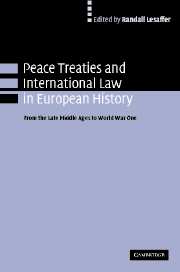Book contents
- Frontmatter
- Contents
- List of contributors
- Acknowledgements
- Table of Treaties
- List of abbreviations
- 1 Introduction
- PART I Peace treaties and international law from Lodi to Versailles (1454–1920)
- PART II Thinking peace: voices from the past
- PART III Thinking peace: towards a better future
- PART IV Making peace: aspects of treaty practice
- 15 The ius foederis re-examined: the Peace of Westphalia and the constitution of the Holy Roman Empire
- 16 The peace treaties of the Ottoman Empire with European Christian powers
- 17 Peace and prosperity: commercial aspects of peacemaking
- 18 The 1871 Peace Treaty between France and Germany and the 1919 Peace Treaty of Versailles
- PART V Conclusion
- Appendix
- Index
16 - The peace treaties of the Ottoman Empire with European Christian powers
Published online by Cambridge University Press: 07 July 2009
- Frontmatter
- Contents
- List of contributors
- Acknowledgements
- Table of Treaties
- List of abbreviations
- 1 Introduction
- PART I Peace treaties and international law from Lodi to Versailles (1454–1920)
- PART II Thinking peace: voices from the past
- PART III Thinking peace: towards a better future
- PART IV Making peace: aspects of treaty practice
- 15 The ius foederis re-examined: the Peace of Westphalia and the constitution of the Holy Roman Empire
- 16 The peace treaties of the Ottoman Empire with European Christian powers
- 17 Peace and prosperity: commercial aspects of peacemaking
- 18 The 1871 Peace Treaty between France and Germany and the 1919 Peace Treaty of Versailles
- PART V Conclusion
- Appendix
- Index
Summary
Introduction
The Ottoman Empire was the only non-Christian European power which, from the Middle Ages to the early twentieth century, has ever been a permanent factor in the political system of Europe. The early state which the Turkish sultans belonging to the house of Osman had formed in Asia minor was transformed into an Empire by fighting against and conquering Byzantium and other Christian states in the Balkans. From 1365 the Ottoman rulers had their residence in Adrianople/Edirne, and from 1453 continuously in Constantinople/Istanbul, in Europe. In the sixteenth century, when their rule was extended to Syria-Palestine, Mesopotamia, Arabia and Egypt, the Ottoman sultans also laid claim to the Caliphate. As caliphs they were regarded as nominal successors to the Prophet Muhammad and therefore as the religious leaders of the whole Muslim community. But throughout the centuries, there have always been important Muslim states which did not recognise the Ottoman sultan–caliph as their supreme authority (such as Persia, Morocco, or the Mogul Empire in India).
The fact that, after the conquest of Constantinople in 1453, Turkish imperial armies had even besieged the Habsburg capital of Vienna in 1529 and once more in 1683 had contributed to the sentiment of mortal menace by Islam, which was widely spread in the respublica christiana. Only in the eighteenth century could the idea of coexistence and good neighbourliness between Christian Europe and theMuslim Turkish Empire become more effective.
- Type
- Chapter
- Information
- Peace Treaties and International Law in European HistoryFrom the Late Middle Ages to World War One, pp. 338 - 364Publisher: Cambridge University PressPrint publication year: 2004
- 2
- Cited by



